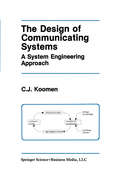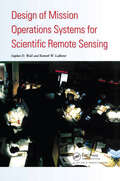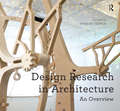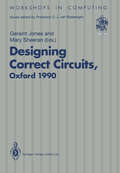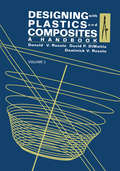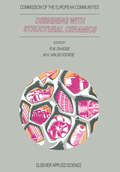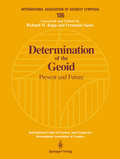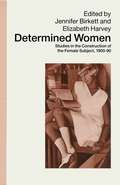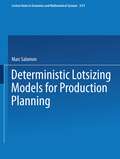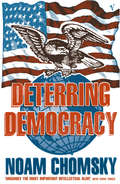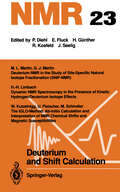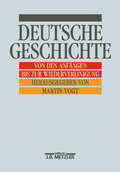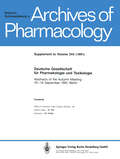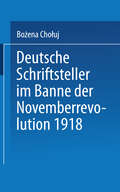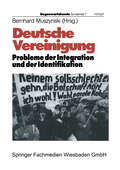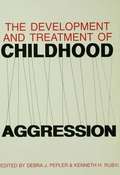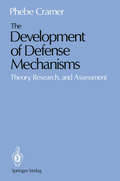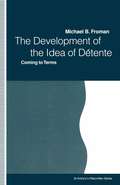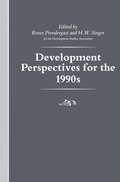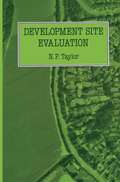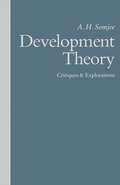- Table View
- List View
The Design of Communicating Systems: A System Engineering Approach (The Springer International Series in Engineering and Computer Science #147)
by C.J. Koomen"The professional schools will resume their professional responsibilities just to the degree that they can discover a science of design, a body of intellectually tough, partly formalizable, partly empirical teachable doctrine about the design process. " [H.A. Simon, 1968} Design is aimed at the transformation or translation of a specification or high level description into a description in terms of some real-world primitives. As such it involves the removal of the uncertainty about the way in which a required system can be realized. To optimally support the design of systems, we must look at the design process as a whole and at the strong relationship that exists between a designer, the applied design method, the required design tools and the ways in which designs can be expressed. This book focuses on that relationship. The application field we are concerned with is the design of systems in which the communication between system elements is a major design feature. Examples of such communicating systems are: communication protocols, telephone exchange control systems, process control systems, highly modular systems, embedded software, interactive systems, and VLSI systems. In summary, we are concerned with systems in which concurrency plays a major role (concurrency defines the mutual relationship between the activities in the different parts of a system or within a collection of systems).
Design Of Mission Operations Systems For Scientific Remote Sensing
by S D Wall K W LedbetterA definitive description of the various models of mission operations systems MOS which provides an account of the design process and of the general principles of the designs themselves. The principles described can be applied to all types of scientific remote sensing.
Design Of Mission Operations Systems For Scientific Remote Sensing
by S D Wall K W LedbetterA definitive description of the various models of mission operations systems MOS which provides an account of the design process and of the general principles of the designs themselves. The principles described can be applied to all types of scientific remote sensing.
Design Research in Architecture: An Overview (Design Research in Architecture)
by Murray FraserWhat is the role of design research in the types of insight and knowledge that architects create? That is the central question raised by this book. It acts as the introductory overview for Ashgate’s major new series, ’Design Research in Architecture’ which has been created in order to establish a firm basis for this emerging field of investigation within architecture. While there have been numerous architects-scholars since the Renaissance who have relied upon the interplay of drawings, models, textual analysis, intellectual ideas and cultural insights to scrutinise the discipline, nonetheless, until recently, there has been a reluctance within architectural culture to acknowledge and accept the role of design research as part of the discourse. However, in many countries around the world, one of the key changes in architecture and architectural education over the last decade has been the acceptance of design as a legitimate research area in its own right and this new series provides a forum where the best proponents of architectural design research can publish their work. This volume provides a broad overview on design research that supports and amplifies the different volumes coming out in the book series. It brings together leading architects and academics to discuss the more general issues involved in design research. At the end, there is an Indicative Bibliography which alludes to a long history of architectural books which can be seen as being in the spirit of design research.
Design Research in Architecture: An Overview (Design Research in Architecture)
by Murray FraserWhat is the role of design research in the types of insight and knowledge that architects create? That is the central question raised by this book. It acts as the introductory overview for Ashgate’s major new series, ’Design Research in Architecture’ which has been created in order to establish a firm basis for this emerging field of investigation within architecture. While there have been numerous architects-scholars since the Renaissance who have relied upon the interplay of drawings, models, textual analysis, intellectual ideas and cultural insights to scrutinise the discipline, nonetheless, until recently, there has been a reluctance within architectural culture to acknowledge and accept the role of design research as part of the discourse. However, in many countries around the world, one of the key changes in architecture and architectural education over the last decade has been the acceptance of design as a legitimate research area in its own right and this new series provides a forum where the best proponents of architectural design research can publish their work. This volume provides a broad overview on design research that supports and amplifies the different volumes coming out in the book series. It brings together leading architects and academics to discuss the more general issues involved in design research. At the end, there is an Indicative Bibliography which alludes to a long history of architectural books which can be seen as being in the spirit of design research.
Designing Correct Circuits: Workshop jointly organised by the Universities of Oxford and Glasgow, 26–28 September 1990, Oxford (Workshops in Computing)
by Geraint Jones Mary SheeranThese proceedings contain the papers presented at a workshop on Designing Correct Circuits, jointly organised by the Universities of Oxford and Glasgow, and held in Oxford on 26-28 September 1990. There is a growing interest in the application to hardware design of the techniques of software engineering. As the complexity of hardware systems grows, and as the cost both in money and time of making design errors becomes more apparent, so there is an eagerness to build on the success of mathematical techniques in program develop ment. The harsher constraints on hardware designers mean both that there is a greater need for good abstractions and rigorous assurances of the trustworthyness of designs, and also that there is greater reason to expect that these benefits can be realised. The papers presented at this workshop consider the application of mathematics to hardware design at several different levels of abstraction. At the lowest level of this spectrum, Zhou and Hoare show how to describe and reason about synchronous switching circuits using UNilY, a formalism that was developed for reasoning about parallel programs. Aagaard and Leeser use standard mathematical tech niques to prove correct their implementation of an algorithm for Boolean simplification. The circuits generated by their formal synthesis system are thus correct by construction. Thuau and Pilaud show how the declarative language LUSTRE, which was designed for program ming real-time systems, can be used to specify synchronous circuits.
Designing with Plastics and Composites: A Handbook
by Donald RosatoFor some time there has been a strong need in the plastic and related industries for a detailed, practical book on designing with plastics and composites (reinforced plastics). This one-source book meets this criterion by clearly explaining all aspects of designing with plastics, as can be seen from the Table of Contents and Index. It provides information on what is ahead as well as today's technology. It explains how to interrelate the process of meeting design performance requirements with that of selecting the proper plastic and manufacturing process to make a product at the lowest cost. This book has been prepared with an awareness that its usefulness will depend greatly upon its simplicity. The overall guiding premise has therefore been to provide all essential information. Each chapter is organized to best present a methodology for designing with plastics and composites. of industrial designers, whether in engineering This book will prove useful to all types or involved in products, molds, dies or equipment, and to people in new-product ventures, research and development, marketing, purchasing, and management who are involved with such different products as appliances, the building industry, autos, boats, electronics, furniture, medical, recreation, space vehicles, and others. In this handbook the basic essentials of the properties and processing behaviors of plastics are presented in a single source intended to be one the user will want to keep within easy reach.
Designing with Structural Ceramics
by R. W. Davidge M. H. Van De VoordeThe last 30 years have seen a steady development in the range of ceramic materials with potential for high temperature engineering applications: in the 60s, self-bonded silicon carbide and reaction-bonded silicon nitride; in the 70s, improved aluminas, sintered silicon carbide and silicon nitrides (including sialons); in the 80s, various toughened Zr0 materials, ceramic matrix composites reinforced with silicon 2 carbide continuous fibres or whiskers. Design methodologies were evolved in the 70s, incorporating the principles of fracture mechanics and the statistical variation and time dependence of strength. These have been used successfully to predict the engineering behaviour of ceramics in the lower range of temperature. In spite of the above, and the underlying thermodynamic arguments for operations at higher temperatures, there has been a disappointing uptake of these materials in industry for high temperature usc. Most of the successful applications are for low to moderate temperatures such as seals and bearings, and metal cutting and shaping. The reasons have been very well documented and include: • Poor predictability and reliability at high temperature. • High costs relative to competing materials. • Variable reproducibility of manufacturing processes. • Lack of sufficiently sensitive non-destructive techniques. With this as background, a Europhysics Industrial Workshop sponsored by the European Physical Society (EPS) was organised by the Netherlands Energy Research Foundation (ECN) and the Institute for Advanced Materials of the Joint Research Centre (JRC) of the EC, at Petten, North Holland, in April 1990 to consider the status of thermomechanical applications of engineering ceramics.
Determination of the Geoid: Present and Future (International Association of Geodesy Symposia #106)
by Richard H. Rapp and Fernando SansòRapid growth of geodetic information provided by the Global Positioning System (GPS) and stringent requirements for a precise geoid in ocean areas for ocean circulation models have spurred interest in geoid studies. As a result, the International Geoid Commission was formed to provide a focus for this important geoid research. Determination of the Geoid: Present and Future is the result of the first meeting of the Commission, held at the Instituto di Topografia, Fotogrammetria e Geofisica at the Politecnico di Milano, June 1990. Six major topics are presented: Global Geopotential Models: Present and Future; Role of Topography in Geoid Computations; the Geoid and the Global Positioning System; the State of Computation of National or Regional Geoids; Software and Data Improvements for Geoid Computations; and Recent Developments in the GEOMED (Determination of the Geoid in the Mediterranean) Project.
Determined Women: Studies in the Construction of the Female Subject, 1900–90
by Jennifer Birkett Elizabeth HarveyThe essays in this collection look at some of the images and categories which have shaped Western women's sense of themselves in the twentieth century. The approach of the collection is interdisciplinary, bringing together the perspectives of literary criticism, social history and linguistics. Its focus is international, with contributions on Britain, France, Germany, the United States and Canada. The collection shows both the similarity and the diversity of women's experience in a world determined by patriarchal assumptions, where women's only hope of change lies in developing a determination of their own.
Deterministic Lotsizing Models for Production Planning (Lecture Notes in Economics and Mathematical Systems #355)
by Marc SalomonThis thesis deals with timing and sizing decisions for production lots, and more precisely, with mathematical models to support optimal tim ing and sizing decisions. These models are called lotsizing models. They are characterized by the fact that production lots are determined based on a trade-offbetween production costs and customer service. Production costs can be categorized as basic production costs, which consist of material costs, labour costs, machine startup costs and over head costs, and inventory related costs, which include costs of capital tied up in inventory, insurances and taxes. Customer service is the capability of the firm to deliver to their clients the products in the quantity they ordered at the agreed upon time and place. The costs of realizing a certain service level are usuaIly very dif ficult to convert into money. They include costs of expediting, loss of customer goodwill, and loss of sales revenues resulting from the short age situation.
Deterring Democracy (Serie General/crítica Ser. #Vol. 222)
by Noam ChomskyFrom World War II until the 1980s, the United States reigned supreme as both the economic and the military leader of the world. The major shifts in global politics that came about with the dismantling of the Eastern Bloc have left the United States unchallenged as the pre-eminent military power, but American economic might has declined drastically in the face of competition, first from Germany and Japan and more recently from the newly prosperous countries elsewhere.In this book, Noam Chomsky points to the potentially catastrophic consequences of this imbalance. He reveals a world in which the United States exploits its advantage ruthlessly to enforce its national interests - and in the process destroys weaker nations.Deterring Democracy offers a devastating analysis of American Imperialism, drawing alarming connections between its repression of information inside the US and its aggressive empire-building abroad.
Deuterium and Shift Calculation (NMR Basic Principles and Progress #23)
by U. Fleischer W. Kutzelnigg H. H. Limbach G. J. Martin M. L. Martin M. SchindlerIn 1931 Vrey, Brickwedde, and Murphy discovered the hydrogen isotope deuterium. The isotopic enrichment was found to arise from the fact that the electrolysis oflight water is faster than of heavy water [1,2]. This success showed that although different isotopes of an element behave identically from a chemical standpoint the different isotopic masses nevertheless lead to both isotope effects on equilibrium as well as on rate constants of chemical reactions. Soon, ratios of equilibrium constants of isotopic reactions were called "equilibrium isotope effects" (EIE), ratios of isotopic rate constants "kinetic isotope effects" (KIE). Isotope effects have been found to be especially large for those elements which are directly involved in bond breaking and bond formation during the reaction studied [3]. Such effects are, therefore, referred to as "primary". Isotopic substitution in atomic sites which maintain all chemical bonds with their neighbors during the reaction of interest leads then only to smaller "secondary" isotope effects. Because of the unique mass relation between the different hydrogen isotopes hydrogen/deuterium isotope effects are particularly large and have attracted most attention. The largest contributions to these effects arise from changes in the vibrational frequencies of the reactants. The theory of equilibrium isotope effects has been founded by Vrey [4] and Bigeleisen [5,6] and has widely been accepted [3].
Deutsch-chinesische Joint Ventures: Wirtschaft — Recht — Kultur
by Volker Trommsdorff Bernhard WilpertDeutsche Gesellschaft für Pharmakologie und Toxikologie: Abstracts of the Autumn Meeting 10–14 September 1991, Berlin
by Deutsche Gesellschaft für Pharmakologie und ToxikologieDeutsche Schriftsteller im Banne der Novemberrevolution 1918: Bernhard Kellermann, Lion Feuchtwanger, Ernst Toller, Erich Mühsam, Franz Jung (Literaturwissenschaft)
by Bożena ChołujDeutsche Vereinigung Probleme der Integration und der Identifikation (Gegenwartskunde - Sonderheft #7)
by Bernhard MuszynskiThe Development and Treatment of Childhood Aggression
by Debra J. Pepler Kenneth H. RubinComprised of papers and commentaries from the Earlscourt Symposium on Childhood Aggression held in Toronto, Canada, this volume reflects the Earlscourt Child and Family Centre's commitment to linking clinical practice to identifiable research-based interventions which are known to be effective in the prevention and treatment of antisocial behavior in children. The education of human services professionals has typically failed to train individuals to work with specific client populations, providing a generalist approach grounded in theoretical assumptions and professional values rather than research and empirical studies. This compelling book serves to fill this gap in professional education in the area of childhood aggression. Representing substantial accomplishments in the advancement of an understanding of the plight of aggressive children and how best to ameliorate their often unpredictable and painful situations, this text allows for cautious optimism that empirical research can have practical consequences for aggressive children and their prospects for a better life. As such, it is a truly important information resource for professionals in the fields of developmental psychology and counseling.
The Development and Treatment of Childhood Aggression
by Kenneth H. Rubin Debra J. PeplerComprised of papers and commentaries from the Earlscourt Symposium on Childhood Aggression held in Toronto, Canada, this volume reflects the Earlscourt Child and Family Centre's commitment to linking clinical practice to identifiable research-based interventions which are known to be effective in the prevention and treatment of antisocial behavior in children. The education of human services professionals has typically failed to train individuals to work with specific client populations, providing a generalist approach grounded in theoretical assumptions and professional values rather than research and empirical studies. This compelling book serves to fill this gap in professional education in the area of childhood aggression. Representing substantial accomplishments in the advancement of an understanding of the plight of aggressive children and how best to ameliorate their often unpredictable and painful situations, this text allows for cautious optimism that empirical research can have practical consequences for aggressive children and their prospects for a better life. As such, it is a truly important information resource for professionals in the fields of developmental psychology and counseling.
The Development of Defense Mechanisms: Theory, Research, and Assessment
by Phebe CramerThe idea that the human mind-that faculty of the intellect which we use to define and discern the truth-might also be used to deceive itself is not new. The classic orator Demosthenes warned of this possibility in 349 B.C. when he wrote that "Nothing is more easy than to deceive one's self; what a man wishes he generally believes to be true." 1 Even Jean Jacques Rousseau, who suggested the possibility of man as "noble savage," alerts us to this paradox, when he writes "Jamais fa nature ne nous trompe; c'est toujours nous qui nous trompons" ("Nature never deceives us; it is always we who deceive ourselves). 2 But it was Sigmund Freud who placed this idea firmly into the field of psychopathology and then, later, into a general psychological theory. According to Freud, understanding the function of a defense mechanism means not only fathoming the origin of pathological symptoms but also comprehending a model of the mind that includes both conscious and unconscious mental processes. From this initial focus on the general process of defense, Freud and his followers went on to identify various forms this process might take, with the result that today we have a list of 3 more than 37 defense mechanisms described in the literature.
Development of the Idea of Detente: Coming to Terms (St Antony's Series)
by Michael B. FromanSince the early 1950s, there has been agreement in the US concerning the desirability of improving relations with the Soviet Union. Policymakers have often disagreed, however, about how to implement policy and this book looks at the policy of individual administrations.
Development Perspectives for the 1990s
by H.W. Singer Renee PrendergastThe most pressing problem for most developing countries is how to reverse the adverse trends of the 1980s and create the conditions for sustainable development. The contributors to this volume bring a great variety of experience, background and interest to bear on this issue. Considerable attention is given to the design of appropriate structural adjustment programmes and the role of debt reduction, food aid and the European Community in this context. The need for an adaptive evolutionary approach to problems of development is, perhaps, the central theme to the volume.
Development Site Evaluation (Building and Surveying Series)
by N. P. TaylorDescribes and appraises the factors that are relevant when evaluating sites for development. These will aid the developer and/or his consultants in deciding whether or not to acquire a site for development. Equally, such information will help the local authority to decide whether to propose a site for development.
Development Theory: Critiques and Explorations
by A.H. SomjeeBy the author of "Voting Behaviour in an Indian Village" and "Reaching Out to the Poor", this book deals with development studies. Topics covered range from Asian development experience and unexplored theoretical explanations to ethno-development.
